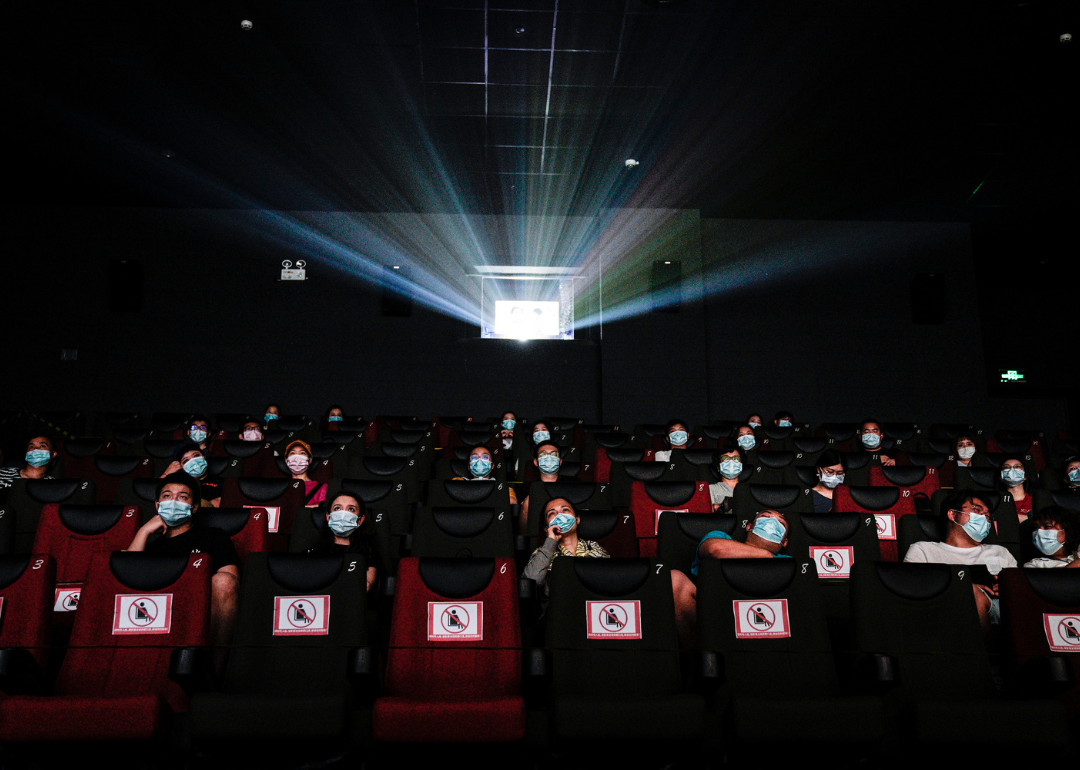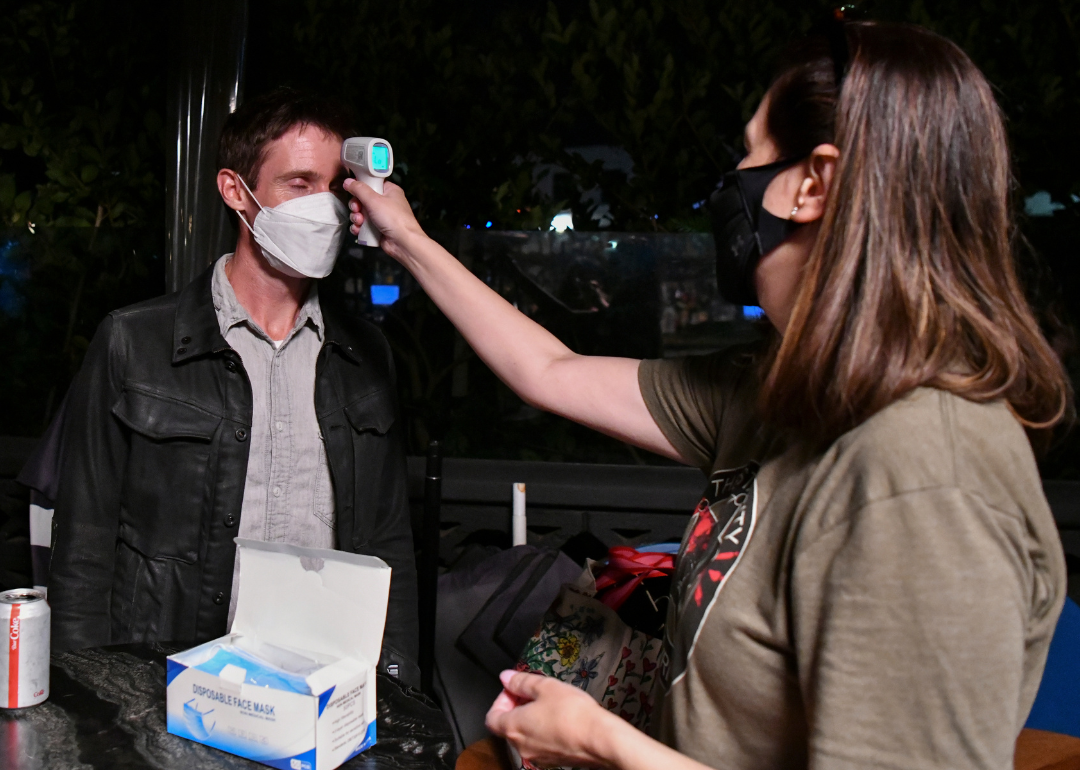How COVID-19 changed the way movies are budgeted and made
Getty Images // Getty Images
How COVID-19 changed the way movies are budgeted and made
A movie theater with people wearing masks during COVID-19.
The COVID-19 pandemic caused massive disruptions to numerous industries, among them the movie business. In the pandemic’s early days, studios and movie theaters were hit with temporary closures, filming delays, and plummeting ticket sales. The pandemic also changed how movies are distributed, as studios looked to diversify their distribution strategies and streamers pushed to expand their content libraries.
Using research from news and industry sites as well as data reports, Giggster broke down some of the crucial ways in which the COVID-19 pandemic has changed the way movies are budgeted and made.
The chaos brought by COVID-19 served as something of a reset button for Hollywood. Studio executives faced unprecedented circumstances in which popular streaming services such as Netflix became the primary means for consuming content while film production of every scale was interrupted by COVID-19-related shutdowns or faced release schedules that could not be accommodated due to theater closures.
2021 box office earnings in the U.S. totaled $4.49 billion, representing a more than $2 billion recovery from the previous year that was still leagues away from 2019’s $11.3 billion haul. Many of 2021’s top films, including “Shang-Chi and the Legend of the Ten Rings” and “Black Widow,” faced limited earnings potential by being simultaneously released on streaming and in theaters.
![]()
David McNew // Getty Images
Success looks different for theatrical vs. streaming releases
A drive-in movie theater filled with cars.
For many Hollywood studios, 2021 provided the rare opportunity to figure out movie distribution patterns that had piqued the curiosity of film industry folks long before the pandemic. For years, the only way to watch a new film was at a movie theater. After COVID, there are no set rules on how a new movie can be released.
In the last year and a half, some movies were released exclusively in theaters before crossing over to digital platforms; other films were made available on streaming platforms the same day as their theatrical releases. Throughout 2021, nearly every new Warner Bros. movie release appeared on HBO Max—a measure being discontinued now as theaters have reopened and Warner and Discovery are expected to merge by the summer of 2023.
Several new streaming services owned by media heavyweights with their own movie studios drew tremendous viewership during the pandemic, among them Peacock, Paramount+, and Disney+—which took many of its live-action and animated features streaming-first, including “Turning Red,” “Black Widow,” and “Raya and the Last Dragon.” Such initiatives have changed how success is measured. For example, “The Many Saints of Newark,” released in fall 2021 by Warner Bros., was a flop at the box office but a major hit for HBO Max.
AaronP/Bauer-Griffin/GC Images // Getty Images
After a slump in revenue, box offices are ready for a comeback
The TCL Chinese Theatre promoting ‘Top Gun: Maverick’ in Hollywood, California.
Throughout the pandemic, movie theaters across the country suffered the blow of plummeting ticket sales. Cineworld Group PLC, the second-largest cinema chain in the world, which owns Regal Cinemas, confirmed in August 2022 that it is preparing to file for bankruptcy protection as a result of poor box office sales in large part due to the pandemic. Cineworld still expects to continue its operations even after filing, but investors in the company could face significant losses.
Nonetheless, there have been sure signs that going to the movies remains a staple activity for Americans. The top movie of 2021, “Spider-Man: No Way Home,” took in more than $572 million in the U.S. that year alone and has grossed more than $800 million overall, making it the third most financially successful movie in history. And thus far 2022 has outearned 2021 by nearly $700 million, with four months yet to go before the year’s end.
Perhaps the biggest reason? Paramount Pictures and Skydance Media’s “Top Gun: Maverick” has been call sign “smash,” surpassing $1.4 billion worldwide in its 13th weekend of release.
GC Images // Getty Images
Studio execs cut back on production costs amid supply chain issues
The Game of Thrones Prequel film set under construction.
As with all other corners of American commerce, the entertainment industry is feeling the weight of inflation compounded by ongoing supply chain issues. Particularly hampering film productions has been a strain on the availability of steel and lumber, which, according to one studio executive, has driven the costs of these materials up by as much as 30%; in one instance, the spike caused a film set to double in price compared to what it would have cost to construct four years ago.
Since early 2021, film studios have faced widespread delays in acquiring nearly all materials necessary for set construction. Compounding this ongoing supply chain problem are rising fuel costs. Many U.S. film studios are located in California, a state where gas currently averages more than $6 a gallon, making fuel expenditures another line item producers are grappling to control.
Perhaps no recent story coming out of Hollywood exemplifies studios’ about-face in terms of controlling costs than the announcement by Warner Bros. Discovery CEO David Zaslav. In August 2022, Zaslav announced several of its in-production film properties, including the highly anticipated DC Comics’ film “Batgirl,” were being shut down and pulled from release altogether for the studio to mitigate what it feared were potential losses at the box office; in the case of “Batgirl,” specifically, the studio is expected to declare the already-finished film as a $90 million tax write-down.
Eduardo Parra/Europa Press // Getty Images
Film shortages
People stand in line to buy movie tickets at the box office.
With theaters being nearly empty for a couple of years as a result of the pandemic, film industry staffers may be excited that more people are getting up from their sofas these days to go to the movies—but there’s now another looming issue, unfortunately. Something that may be missing from the cinemas this fall is the actual movies.
In 2021, 403 films were released in the U.S. and Canada, a 20% increase over 2020 but nowhere near the 792 films released in pre-pandemic 2019. The shortage of new films being made and released is likely to have an adverse effect on ticket sales for movie theaters that were already struggling to stay afloat during the heaviest days of the pandemic. Supply chain and production setbacks continue to plague film productions, large and small. Moreover, the major studios’ codification of resources toward large-scale and big-budget productions means they can afford to produce fewer projects but also that the onus on those projects they do release is significantly greater than in years past.
Rodin Eckenroth // Getty Images
Lack of COVID-19 insurance funding
A person does a temperature check on an indie film set.
While larger film studios have more wiggle room with their budgets, indie filmmakers are still grappling with financing independent productions—an increasingly complicated feat since the pandemic.
When the pandemic first arose, insurance companies excluded COVID-19 from their policies. This resulted in a domino effect with banks not wanting to accept completion bonds that independent filmmakers count on to get funding. Completion bonds guarantee that productions will be within budget and will wrap on time. The lack of insurance coverage coupled with surging production costs has made it challenging for indie filmmakers who are struggling to get their projects underway.
This story originally appeared on Giggster and was produced and
distributed in partnership with Stacker Studio.






